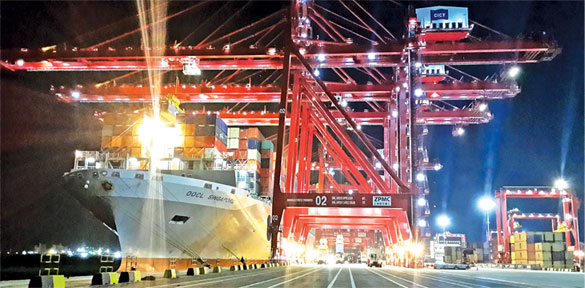Apparel exports drive Colombo’s transshipment business
New report optimistic :
The growth of apparel exports from South Asia will be the key driver of the
region’s container transhipment business with Colombo Port strengthening its hub
position supported by new capacity created with the commissioning the Colombo
International Container Terminal (CICT).
 “The continuing growth of the apparel industry will be key to future gateway
traffic and transshipment volumes for South Asia, where in the first quarter
container throughput rose 5.3 percent, higher than any other region, and 10
times the global average,” says a new report by Drewry, an international
shipping research organisation. “The continuing growth of the apparel industry will be key to future gateway
traffic and transshipment volumes for South Asia, where in the first quarter
container throughput rose 5.3 percent, higher than any other region, and 10
times the global average,” says a new report by Drewry, an international
shipping research organisation.
South Asia region
Aside from the economic energy of the region – the IMF expects GDP growth for
the four countries between 2015 and 2020 to be well above the world average with
India topping them at around 8% – part of the reason for the upswing in South
Asia container handling is the greater incidence of transhipment.
Apparel exports from the region have grown by around 10 percent annually from
2005 to 2014, with Sri Lanka alone setting a sales target of $8 billion by 2020,
the report said.
“Amid generally weak demand around the world, the South Asia region is the
shining light for container growth.”
Lagging port infrastructure in the region for many years meant that container
lines preferred to base their hub and spoke networks in the Middle East and
Southeast Asia, but the development of Colombo as a viable hub following the end
of the civil war in 2009 has boosted the South Asia container count.
“The Sri Lankan hub’s growth was tapered by the continuous upsizing of vessels
with deeper draft requirements, but the opening of the Colombo International
Container Terminal terminal at the new South Harbour in 2013 with 20-metre
access channel, has kick-started further activity,” it said.
“Aided by some very competitive transhipment tariffs, Colombo attracted another
144,000 twenty foot equivalent units (TEUs) in the first quarter of 2016
compared to a year ago, equating to an upswing of 11.5%.
The port is now a key East-West hub with about three-quarters of all traffic
transhipped to other countries in the region, and has benefited from the boom in
garment exports from Bangladesh and from Sri Lanka itself.”
Drewry’s report said port throughput in South Asia grew by 5.3% in 2015 to reach
just under 22 million TEU, which puts the region on a par with the East Coast of
North America. Each of the South Asian countries contributed to the additional
TEU count with India’s throughput growing by 234,000 TEU, Sri Lanka’s by 278,000
TEU, Pakistan’s by 274,000 TEU and Bangladesh’s by 324,000 TEU.
Bangladesh
New port developments in the pipeline across South Asia will attract more direct
services and lessen the need for feeder service to/from the Middle East or
Southeast Asia, keeping more of the volume within the region, Drewry said.
For example, there are plans for a deep-water container terminal in Bangladesh,
which is expected to be built around 2020.
Because the balance of Bangladesh’s business favours trade with the Far East it
is more naturally connected towards the Southeast Asia hubs, but they stand to
lose some of that traffic when the new port opens.
“The region is also set to gain transhipment alternatives to Colombo in the near
future with new developments in India (Mundra at the forefront) and in Sri Lanka
(Hambantota), which will make the region even more attractive to carriers.”
The report said that South Asia’s performance comes at a time that growth in
container shipping is becoming a ‘rare commodity’ with global port throughput
only up by 1% in 2015 (the second lowest on record behind 2009) and the first
quarter of 2016 even worse with only a 0.5% rise.
“That the industry can point to any growth at all is largely down to strong
volumes in the South Asia/Indian Subcontinent region, which saw box port traffic
(including empties and transhipment) gain 5.3% in the first three months of 2016
– the highest attained by any region and 10 times the global average.” |

